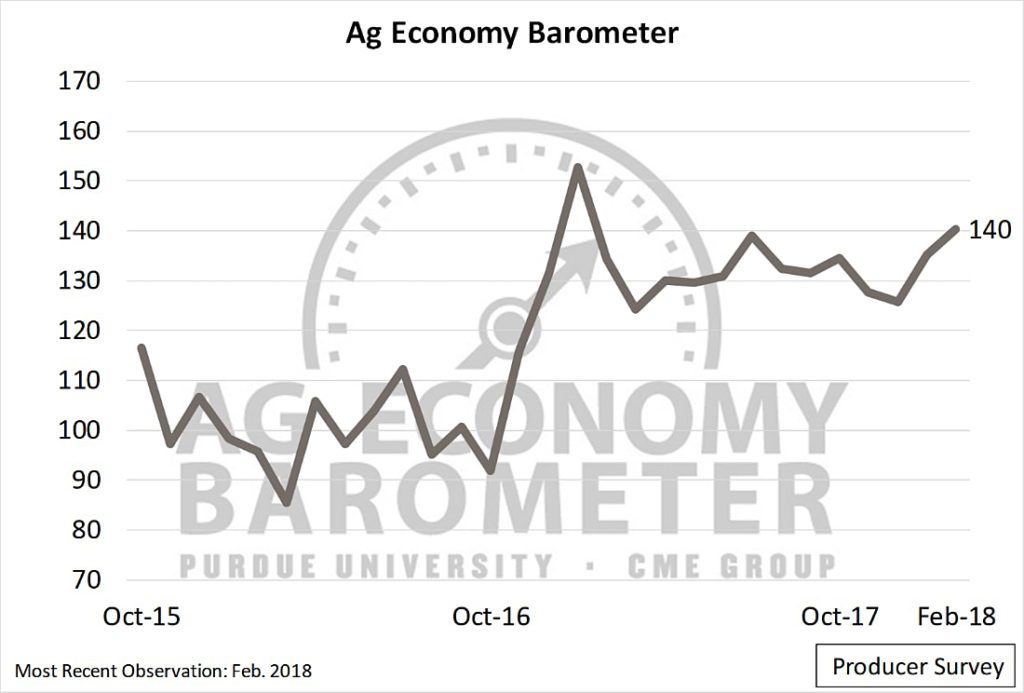Mar 6, 2018Purdue University: Ag producers uncertain about NAFTA
Agricultural producer attitudes improved for the second straight month in February, but producers continued to indicate uncertainty surrounding a possible U.S. withdrawal from the North American Free Trade Agreement (NAFTA), according to the Purdue University/CME Group Ag Economy Barometer.
The barometer read 140 in February, a 5-point increase from January’s reading of 135. The increases mark a strong 14-point jump since December. February also marked the second-highest barometer reading since data collection began in 2015.
Each month, 400 U.S. agricultural producers are surveyed to discern their attitudes and sentiments regarding the status of the U.S. farm economy.
The drivers of sentiment have shifted since the barometer hit a survey high of more than 150 points back in January 2017, said James Mintert, the barometer’s principal investigator and director of Purdue University’s Center for Commercial Agriculture.
“In early 2017, producer sentiment was largely driven by an uptick in the future-looking measure of producer sentiment, the Index of Future Expectations,” he said. “More recently, the barometer’s upturn has been driven in part by a shift toward more positive sentiment regarding current farm financial conditions, as measured by the Index of Current Conditions.”
In the February survey, researchers asked agricultural producers about the likelihood of the U.S. withdrawing from NAFTA. On a scale of 1-9, the most common response at 39 percent was a neutral rating of 5, while 34 percent of respondents said they thought a U.S. NAFTA withdrawal was likely (a rating of 6 or higher), and 29 percent thought withdrawal was unlikely (a rating of 4 or lower).
“Taken as a whole, the February survey indicates that producers are really uncertain about the future of NAFTA,” Mintert said. “But despite the uncertainty surrounding NAFTA, producers remain optimistic about the future of U.S. agricultural exports,” Mintert said.
A full 50 percent of responding producers said they expect U.S. agricultural exports to increase over the next five years, while another 37 percent said they expect exports to remain about the same. Only 13 percent said they expect U.S. agricultural exports to be lower five years from now.
In addition to trade, February’s survey asked producers about their expectations for corn and soybean production in the 2018 cropping year. A majority – 71 percent – said soybeans would be more profitable than corn, up 4 percent from the number of respondents who expected soybeans to be more profitable when surveyed in February 2017.
Despite expectations that soybeans will be more profitable, 81 percent of those surveyed said they expect their soybean acreage in 2018 will be unchanged. Only 10 percent expect to plant more soybeans than a year earlier. This differs from the February 2017 survey, when 18 percent of producers reported they expected to increase their soybean acreage.
For more on producers’ trade expectations and planting intentions, read the full February Ag Economy Barometer report at http://purdue.edu/agbarometer.
Above: The February Purdue/CME Group Ag Economy Barometer showed an increase in agricultural producer sentiment for the second-straight month. The barometer has jumped 14 points since December 2017. (Purdue/CME Group Ag Economy Barometer/David Widmar)















